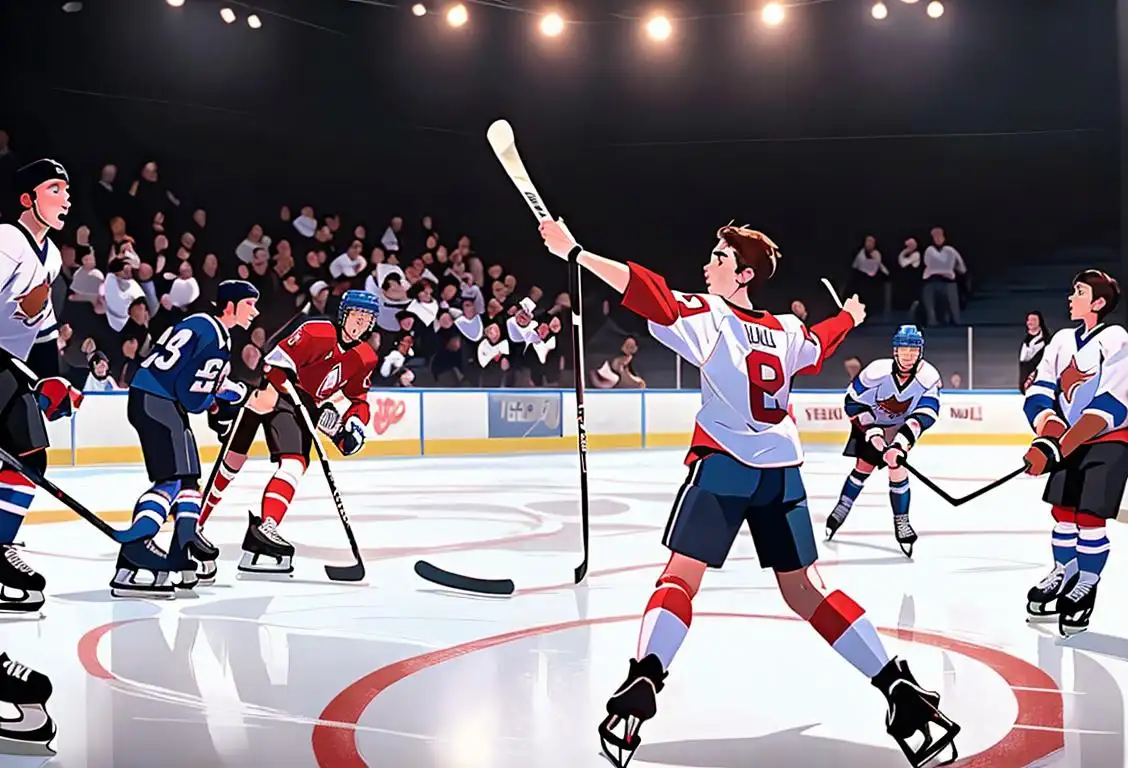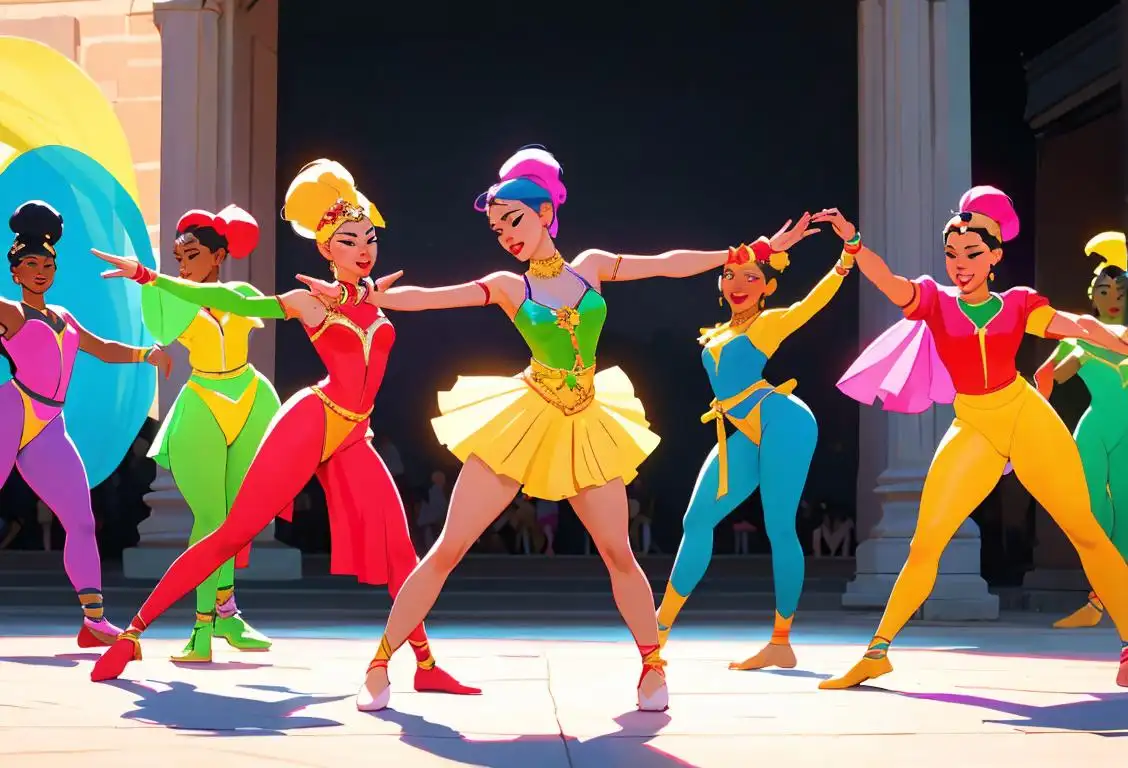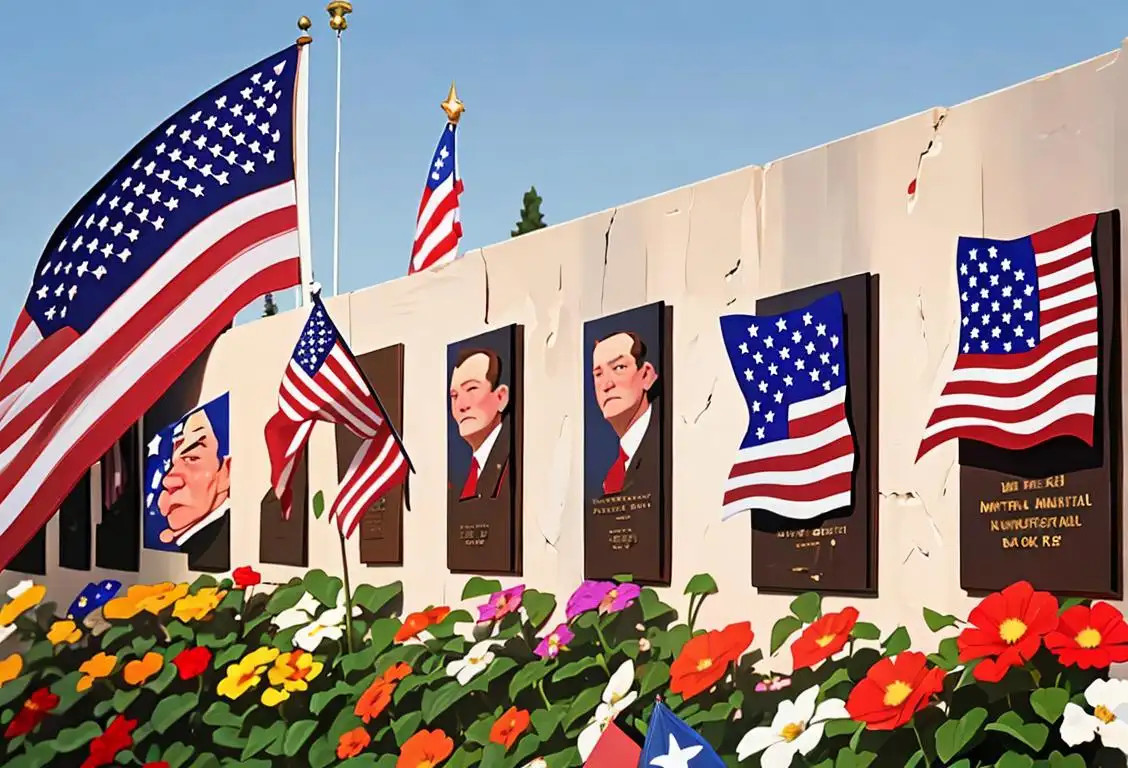National Hockey Day

Hey there, hockey fans! Get ready to lace up your skates and hit the ice because it's National Hockey Day! This is the day we celebrate all things hockey, from the heart-pounding excitement of the game to the legendary players who have left us in awe. So grab your favorite jersey and let's dive into the thrilling world of hockey!
When is Hockey Day?
It's national hockey day on the 21st February.
The History of National Hockey Day
Every year on February 21st, hockey enthusiasts from around the world come together to honor the sport that has captured our hearts and frozen our toes. National Hockey Day was established to celebrate the rich history and cultural significance of hockey, both on and off the ice.
While the origins of National Hockey Day are a bit murky, it is believed to have started in Canada, the birthplace of hockey. Canadians, who are known for their love of the sport, wanted a day to showcase and celebrate their national pastime. And so, National Hockey Day was born.
Since then, the celebration has spread across the globe, with fans and players alike participating in various activities and events to mark the occasion. From pickup games on frozen ponds to professional matches in packed arenas, the spirit of hockey radiates on National Hockey Day.
One of the key goals of National Hockey Day is to promote the sport and inspire the next generation of players. It provides an opportunity for hockey organizations and communities to reach out to newcomers and introduce them to the joy and camaraderie that comes with being part of the hockey world.
Fun Facts about Hockey
Did you know that the first indoor hockey game was played in 1875 in Montreal, Canada? The game took place at the Victoria Skating Rink, and ever since then, hockey has become a permanent fixture in arenas worldwide. Not only that, but the Stanley Cup, awarded annually to the champion of the National Hockey League (NHL), is the oldest professional sports trophy in North America!
History behind the term 'Hockey'
1772
The birth of shinty on the ice
In 1772, the origins of hockey can be traced back to a Scottish winter sport called shinty. Shinty is a field game played with sticks and a ball, but during the colder months, it was adapted to be played on frozen lakes and ponds. This early form of hockey on ice laid the foundation for the sport we know today.
1205
The Origins of the Game
The history of hockey can be traced back to the 13th century in England. The sport, in its earliest form, was known as 'hockie' or 'hokie' and was played on fields or frozen ponds. The objective of the game was to strike a ball or wooden block, called a 'hawkey,' with a curved stick towards a designated target or goal.
18th century
Origins in England
Ice hockey, as we know it today, can trace its roots back to England in the 18th century. It is believed to have been heavily inspired by various stick and ball games played on the ice during winter. The term 'hockey' itself is believed to have been derived from the French word 'hoquet', meaning shepherd's crook, which was likely used as an early hockey stick.
1773
Birth of Shinny
The term 'hockey' traces its origins back to the game of 'shinny' played in Nova Scotia, Canada, in the year 1773. Shinny was a popular informal game played on ice or fields, using curved sticks and a ball or a wooden object for striking. This precursor to modern hockey laid the foundation for the evolution of the sport.
1363
Origins in Medieval Europe
The term 'hockey' traces its origins back to the 14th century in Medieval Europe. The exact year of its introduction is uncertain, but the sport was widely played in countries like England, Scotland, and the Netherlands. Back then, it was known by various names such as 'hockie', 'hockiee', or 'hokie', and it was played using curved sticks and a ball.
19th century
The Early Origins
The origins of hockey can be traced back to the 19th century in Canada, where it was initially played outdoors on frozen ponds and rivers during the winter months. The game was developed by British soldiers stationed in Canada, who adapted a variety of stick and ball games, such as field hockey and shinny, to create a new sport.
18th century
The Origins
Hockey dates back to the 18th century when it emerged as a popular winter sport in rural areas of Canada. It is believed to have been derived from various stick-and-ball games played in Europe, including hurley and bandy. Early versions of hockey were played on frozen ponds and lakes, where players used rudimentary wooden sticks to hit a ball or a wooden block around the ice.
18th century
The origins of ice hockey
Ice hockey, the precursor to modern-day hockey, is believed to have originated in the late 18th century in Canada. The exact year is uncertain, but the sport began to gain popularity in the early 19th century. It was played on frozen ponds and lakes, with players using sticks to hit a wooden puck.
1875
Formation of the first official hockey association
In the year 1875, the world's first official hockey association, the Hockey Association (HA), was formed in England. The formation of the HA was significant as it standardized the rules and regulations of the sport, leading to its growth and popularity. This laid the foundation for the modern game of hockey we know today.
1875
First Modern Hockey Game
In 1875, the first modern hockey game, as we know it today, was played in Montreal, Canada. This game featured the use of a wooden puck rather than a ball, rendering it more similar to the sport of hockey played today. The game quickly gained popularity, and the term 'hockey' began to be used more widely to describe this increasingly organized and regulated sport.
1856
The Birth of Modern Hockey
In 1856, the first organized indoor hockey game was played in Montreal, Canada. The match took place at the Victoria Skating Rink and marked a significant moment in the evolution of the sport. James George Aylwin Creighton, a student at McGill University, is often credited with formalizing the rules of modern ice hockey. His efforts laid the foundation for the sport's development and popularization.
19th century
Evolution and Spread
During the 19th century, hockey started to gain popularity and evolved into a more organized sport. It was particularly embraced in Canada, where the modern game of ice hockey began to take shape. In 1875, the first indoor hockey game was played in Montreal, which marked a major milestone in the sport's development. The term 'hockey' became commonly used to refer to the game, differentiating it from variations played on grass or with different equipment.
18th century
Evolution as an Outdoor Game
During the 18th century, hockey gained popularity as an outdoor team sport. The game was played on ice or grass with a ball or a cork wrapped in leather. Various versions of the game emerged across different regions, such as shinty in Scotland and bandy in Russia. Rules started to be formalized, and the use of a wooden puck became more common.
1840s
The emergence of ice hockey
During the 1840s, various versions of ice hockey started to gain popularity in Canada. British soldiers stationed in Canada introduced their own versions of hockey, combining elements of shinty and field hockey with local indigenous games. The first recorded organized indoor game of ice hockey took place in Montreal in 1875, officially marking the emergence of the modern sport.
1875
The First Hockey Game
In 1875, the first official indoor hockey game was played in Montreal, Canada. The game was organized by James Creighton, a Canadian athlete, and was played with nine players on each side. This game is considered a significant milestone in the history of hockey as it marked the formalization of the rules and structure of the game.
1875
Introduction of organized hockey
In 1875, the first organized indoor game of hockey was played in Montreal, Canada. This game, known as the 'Montreal Rules,' formed the foundation of modern ice hockey. The Montreal Rules introduced concepts like the use of a puck instead of a ball and the restrictions on stick and body contact.
19th century
Birth of Modern Hockey
In the mid-19th century, the modern concept of hockey started taking shape. The first codified set of rules was developed in 1867 by the Montreal Winter Club in Canada. These early rules contributed to the formation of ice hockey as we know it today. The use of a rubber puck became standard, and teams began using ice skates instead of their regular shoes.
1888
The birth of modern ice hockey
In 1888, the term 'hockey' became synonymous with ice hockey when the Canadian Amateur Hockey Association was established. Ice hockey rapidly gained popularity in Canada, and the term 'hockey' soon became widely associated with the ice-based variant of the sport. Ice hockey played a crucial role in shaping the term's cultural impact.
1886
Formation of National and International Associations
In 1886, the Canadian Amateur Hockey Association (CAHA) was established, becoming the first national hockey association in the world. This organization played a crucial role in standardizing the rules of the game and promoting its growth within Canada. Additionally, in 1908, the International Ice Hockey Federation (IIHF) was formed, leading to the international expansion of the sport.
20th century
Establishment as a National Sport
In the early 20th century, hockey solidified its position as a national sport in Canada. The sport gained massive popularity, and leagues began to form across the country. The professional National Hockey League (NHL) was established in 1917, further contributing to the growth and recognition of hockey as a prominent sport. The term 'hockey' became synonymous with ice hockey, while variations like field hockey maintained their own distinct terms.
1880s
Formation of national hockey associations
Throughout the 1880s, various regional hockey associations were established in Canada, leading to the formation of the Amateur Hockey Association of Canada (AHAC) in 1886. The AHAC became the first governing body for ice hockey, standardizing rules, equipment, and organizing leagues and championships.
1875
Rules Standardization
In 1875, the first hockey association, the National Hockey Association (NHA), was formed to establish standardized rules for the game. The NHA played a crucial role in shaping the structure and regulations of professional hockey. It later evolved into the National Hockey League (NHL), which remains one of the most prestigious ice hockey leagues worldwide.
1886
Formation of the International Hockey League
The International Hockey League (IHL) was formed in 1886, with teams from both Canada and the United States. The IHL marked the first instance of formal international hockey competition. The establishment of this league solidified the term 'hockey' as the standard reference for the sport, further spreading its popularity and cultural significance.
1879
The invention of the first ice hockey puck
In 1879, the first standardized ice hockey puck was created. Prior to this invention, various objects were used as pucks, including frozen cow dung. The new puck was made of rubber and had a flat disc-like shape, allowing for better control and predictable movement on the ice.
1893
Introduction of the Stanley Cup
In 1893, Lord Stanley of Preston, the Governor General of Canada, donated a trophy known as the Stanley Cup to be awarded to the top hockey team in Canada. It became the symbol of hockey supremacy and is still awarded annually to the National Hockey League (NHL) champions.
1875
Formation of the National Hockey Association
In 1875, the National Hockey Association (NHA) was formed in Canada, marking a significant milestone in the sport's history. The NHA played a crucial role in organizing professional ice hockey leagues and competitions. It served as a predecessor to the National Hockey League (NHL), which was established in 1917.
1893
Creation of the first professional league
The year 1893 marked the formation of the first professional ice hockey league, the Quebec Amateur Hockey Association (QAHA). This league paved the way for the establishment of other professional leagues, leading to the growth and popularity of ice hockey as a professional sport around the world.
1917
Birth of the National Hockey League
On November 26, 1917, the National Hockey League (NHL) was founded in Montreal, Canada. The NHL initially consisted of four teams, all based in Canada. Over the years, the league grew in popularity and expanded to include franchises from the United States, becoming the premier professional ice hockey league in the world.
1917
Birth of the National Hockey League
In 1917, the National Hockey League (NHL) was founded, becoming the premier professional hockey league in North America. The formation of the NHL further cemented the term 'hockey' as a household name, drawing attention to the sport on a much larger scale. The NHL's continued growth and influence have contributed to the global recognition of 'hockey' as a significant cultural phenomenon.
1924
Inclusion in the Winter Olympics
The term 'hockey' reached new heights of international recognition when it was included in the Winter Olympics program for the first time in 1924. This further solidified its global popularity and contributed to the widespread adoption of the term 'hockey' as a reference to the sport played on ice.
21st century
Global Phenomenon
In the 21st century, hockey has become a global phenomenon. It is now played, watched, and celebrated in many countries around the world. The term 'hockey' is universally recognized as referring to the sport played on ice, and it has become an integral part of popular culture. International competitions like the Olympics and World Championships further showcase the widespread appeal and competitiveness of hockey on a global scale.
20th century
International Expansion
Ice hockey's popularity continued to grow throughout the 20th century, spreading beyond Canada to other countries. The sport developed strong followings in countries like the United States, Russia, Sweden, Finland, and Czechoslovakia (now the Czech Republic and Slovakia). International competitions, such as the Winter Olympics and the IIHF World Championships, played a significant role in promoting the game globally.
1920s-1930s
The Golden Age of Hockey
The 1920s and 1930s are often referred to as the Golden Age of Hockey. During this period, the sport saw a surge in popularity, and legendary players like Howie Morenz, Eddie Shore, and King Clancy emerged as household names. The era was characterized by intense rivalries, high-scoring games, and the introduction of innovations such as artificial ice and penalty shots.
1920
Inclusion in the Olympic Games
Hockey made its Olympic debut in the Summer Olympics held in Antwerp, Belgium, in 1920. This major milestone propelled the sport onto the international stage, garnering widespread attention and solidifying 'hockey' as a renowned global sport. The inclusion of hockey in the Olympics has since become a celebrated event, capturing the hearts of fans from around the world.
1910
Introduction of the first artificial ice rink
In 1910, the first artificial ice rink was introduced in the United States. This innovation allowed ice hockey to be played in any climate, further expanding the reach of the sport and enabling it to be a year-round activity for enthusiasts.
1924
Introduction of Winter Olympic Hockey
Hockey made its debut in the Winter Olympic Games in 1924. The tournament was held in Chamonix, France, and featured both men's and women's ice hockey. This event further popularized the sport on an international stage and led to a growth in its global recognition and participation.
1971
Field hockey and its global recognition
While 'hockey' had primarily been associated with ice hockey, the year 1971 marked a turning point when field hockey was recognized globally. The International Hockey Federation (FIH) was founded, serving as the governing body for field hockey. Field hockey became immensely popular, especially in countries like India and Pakistan.
1892
Introduction of women's hockey
Women's hockey has a long history, with its roots tracing back to the late 19th century. In 1892, the first recorded women's hockey game took place in Barrie, Ontario. The sport gained popularity among women, and in 1917, the first women's hockey league, the Western Canada Ladies Hockey Association, was formed.
1990s
Introduction of the NHL Salary Cap
In the 1990s, the National Hockey League introduced a salary cap system to ensure competitive balance among teams. The salary cap put limits on how much teams could spend on player salaries, aiming to create a more level playing field. This move had a profound impact on the financial landscape of the sport and influenced team strategies in player acquisitions and contract negotiations.
1920
Formation of the National Hockey League
On November 26, 1917, the National Hockey League (NHL) was formed in Montreal, Canada, as a successor to the National Hockey Association. The NHL is the premier professional ice hockey league in North America, consisting of teams from the United States and Canada.
1994
Introduction of roller hockey
In 1994, the term 'hockey' expanded its horizons once again with the introduction of roller hockey. The sport gained momentum, particularly in North America and Europe. Roller hockey is a variant played on roller skates, combining elements from both ice and field hockey. Its inclusion further diversified the cultural impact of the term 'hockey.'
1920
The founding of the National Hockey League
The National Hockey League (NHL) was established in 1917, but in 1920, it became the premier professional ice hockey league in North America. The NHL's formation brought together top teams from various leagues and laid the foundation for the modern structure of professional ice hockey.
1998
Inclusion in the Winter Olympics
After several decades of lobbying, hockey was finally included as an official sport in the Winter Olympics in 1998. Since then, the Olympic ice hockey tournament has become one of the most eagerly anticipated events, featuring both men's and women's competitions. The intense matches between rival nations have brought widespread attention to the sport on a global scale.
1991
Formation of the International Ice Hockey Federation
The International Ice Hockey Federation (IIHF) was founded in 1991 as the governing body for international ice hockey. It oversees various international competitions, including the Ice Hockey World Championships and the Winter Olympics. The IIHF plays a crucial role in promoting and developing the sport worldwide.
1998
Inauguration of the International Ice Hockey Federation Hall of Fame
In 1998, the International Ice Hockey Federation (IIHF) inaugurated its Hall of Fame. This honored institution aims to recognize the achievements and contributions of notable individuals who have made a significant impact on the sport of hockey. The establishment of the IIHF Hall of Fame further solidifies the enduring legacy of 'hockey' and its rich cultural heritage.
Present
Hockey's global influence and diverse forms
Today, the term 'hockey' encompasses a wide range of sports played on various surfaces, from ice and field to roller and even street hockey. The cultural impact of hockey is undeniable, with passionate fan bases, professional leagues, and international competitions worldwide. 'Hockey' has become a term that unites people across continents and signifies the love for the sport in its many exciting forms.
1988
Introduction of field hockey at the Olympics
While hockey predominantly refers to ice hockey, field hockey is another variant of the sport played on grass or artificial turf. In 1988, field hockey was reintroduced to the Summer Olympics after a long absence. The sport has since become an integral part of the Olympic program.
1998
Debut of women's ice hockey at the Winter Olympics
Women's ice hockey made its debut as an Olympic sport in 1998 at the Winter Olympics held in Nagano, Japan. The inclusion of women's ice hockey in the Olympic program represented a significant milestone for gender equality in the sport and further popularized the game among female athletes.
Present
Global Popularity and Evolution
Today, hockey has become a beloved sport around the world, with a significant following in countries like Canada, the United States, Russia, Sweden, and Finland. The game has evolved over the years, with advancements in equipment, playing techniques, and the introduction of professional leagues in various countries. Hockey has become not only a sport but also a symbol of national pride and cultural identity.
Did you know?
Did you know that the first indoor hockey game was played in 1875 in Montreal, Canada? The game took place at the Victoria Skating Rink, and ever since then, hockey has become a permanent fixture in arenas worldwide. Not only that, but the Stanley Cup, awarded annually to the champion of the National Hockey League (NHL), is the oldest professional sports trophy in North America!Tagged
awareness fun sportsFirst identified
21st February 2016Most mentioned on
21st February 2016Total mentions
105Other days
Wing Day
Left Handers Day
Golf Day
Fitness Day
Foundation Day
Cancer Survivors Day
Dance Day
Memorial Day
Gymnastics Day
Student Athlete Day









